As a student learning Spanish vocabulary there are a few things you can do like: practice speaking, listening, and writing to reinforce your vocabulary. Setting clear goals for your language learning journey will help you stay motivated and focused. It is important to understand the basics of Spanish vocabulary before diving into more complex topics. Here are some key concepts to keep in mind:
Like any other language grammar and vocabulary are two essential components of Spanish. Learning the basic rules of grammar is crucial in order to construct sentences correctly. Vocabulary, on the other hand, is the set of words that make up a language.
In Spanish, all nouns have a gender. This means that every noun is either masculine or feminine. As a beginner student, it is important to learn the gender of each noun to use them correctly. For more advanced students, learning the exceptions to the rules will allow you to have a deeper understanding.
Spanish has several tenses that are used to express different actions or states of being. Students start learning the grammar basics and continue their progress with more uses and complex tenses.
Some common vocabulary words and phrases include greetings, numbers, colors, and family members. It is important to practice using these words and phrases in context in order to become comfortable using them in conversation.
How do I start learning Spanish vocabulary?
If you’re new to learning Spanish, it can be overwhelming to know where to start. But don’t worry, with the right approach, you can build your vocabulary in no time. Here are some tips to get you started:
What Spanish words should I learn first?
When you’re just starting, you should focus on the most common words in the Spanish language. This will give you a solid foundation to build on and help you understand basic conversations. Some common words to start with include:
- Hola (hello)
- Adiós (goodbye)
- Por favor (please)
- Gracias (thank you)
- Sí (yes)
- No (no)
- ¿Cómo estás? (how are you?)
- Bien (good)
- Mal (bad)

Basic Spanish Words and Phrases for Every Conversation
Learning basic Spanish words and phrases can help you have simple conversations in Spanish. Here are some examples:
- ¿Cómo te llamas? (what’s your name?)
- Me llamo… (my name is…)
- ¿De dónde eres? (where are you from?)
- Soy de… (I’m from…)
- ¿Hablas español? (do you speak Spanish?)
- Sí, hablo español. (yes, I speak Spanish.)
- No, no hablo español. (no, I don’t speak Spanish.)
- Mucho gusto. (nice to meet you.)
- Lo siento. (I’m sorry.)
Setting Goals and Milestones
As a teacher, I always set learning goals with my beginner students. First, we discuss why they are learning Spanish. After that, we agree on what to focus on to achieve those objectives. The next step is to decide how much time to spend during the week.
As a language learner, I also set goals for what I want to achieve. For example, at the moment I’m learning Irish, so my focus now is on learning the basic words and phrases. I’m currently using Duolingo and my goal is to practice everyday for at least 15 minutes.
Setting goals and milestones can help you stay motivated and track your progress. Here are some tips to get started:
- Set a goal for how many words you want to learn each week or month.
- Use flashcards or an app to quiz yourself on new vocabulary.
- Practice using new words in context by writing sentences or having conversations with a language teacher / partner.
- Make time during your week to learn new words and be consistent. Don’t give up if you haven’t practiced for a while, you can always pick up where you left it!
Apps and Resources to Learn Spanish Vocabulary
From my experience, I know that learning vocabulary on your own can be challenging, but taking time to choose the right apps and resources, you can make significant progress. Here are some of the best language learning apps and materials to practice Spanish vocabulary.
Language Learning Apps and Platforms to Practice Vocabulary
There are several language learning apps and platforms that can help you practice Spanish vocabulary. Duolingo is a popular app that offers interactive lessons to help you learn new words and phrases. The app is free and offers a range of exercises, including flashcards and listening exercises. In this article I wrote about if it is possible to become fluente with Duolingo and other learning apps.
FluentU is another language learning app that can help you practice Spanish vocabulary. The app uses real-world videos, such as news clips and commercials, to teach you new words and phrases. It also offers interactive exercises to help you practice what you’ve learned.
Here are general reviews that users wrote by December 2023:
| Positive Aspects | Negative Aspects |
| Engaging Content: Users appreciate apps that offer interesting and engaging content to keep them motivated. User-Friendly Interface: Intuitive and easy-to-navigate interfaces contribute to a positive learning experience. Varied Learning Resources: Apps that provide a variety of learning materials, including videos, quizzes, and interactive exercises, are often well-received. Progress Tracking: Users like features that allow them to track their progress and set personalized learning goals. | Technical Issues: Some users may experience bugs, crashes, or technical glitches that impact the app’s functionality. Subscription Costs: Complaints about subscription costs or limitations on free content are common concerns. Language Depth: Users may find that some apps lack depth in teaching more advanced language concepts. Personal Learning Style: What works well for one user may not suit another, so negative reviews could be subjective based on individual preferences. |
If you prefer online courses, there are several options available, including Babbel and Rosetta Stone. Babbel offers courses focused on specific topics, such as travel and business, while Rosetta Stone offers a more immersive experience, using pictures and audio to teach you new words and phrases.
Textbooks to Learn Vocabulary for Beginners in Spanish
If you’re just starting to learn Spanish, there are several materials and textbooks that can help you build your vocabulary. “Spanish Vocabulary for Beginners” by Language Learning University is a great resource that offers a range of exercises to help you learn new words and phrases. The book also includes grammar explanations and pronunciation tips.
For a more comprehensive approach, “Spanish Made Simple” by Judith Nemethy is an excellent choice. The book covers all aspects of the Spanish language, including grammar, vocabulary, and pronunciation. It also includes exercises and quizzes to help you practice what you’ve learned.
If you prefer audio resources, “Spanish Vocabulary Builder” by Lingo Mastery is a great option. The audiobook offers a range of vocabulary lists and exercises to help you build your vocabulary. It also includes a learning engine that adapts to your progress, ensuring that you’re always learning at the right level.
“Practice Makes Perfect: Spanish Vocabulary” is a practice workbook for beginning and advanced-beginning level learners of Spanish.
Materials to Learn Vocabulary for Beginners in Spanish
There are several apps and resources available to help you learn Spanish vocabulary.
If you are looking for a dictionary, “Spanish vocabulary for English speakers – 9000 words” by Andrey Taranov might be a good option. This dictionary contains over 9000 commonly used words which are arranged according to their meaning, not alphabetically. The Content is presented in three columns to facilitate the reviewing and self-testing processes and each theme is composed of small blocks of similar lexical units.
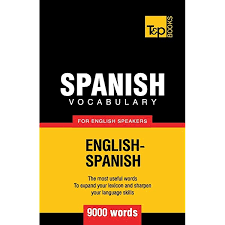
Flashcards are a great option for more visual learners, in that case you can get “Spedemy Spanish Flash Cards for Adults, Kids“. This card set contains 276 cards, 720 words in 47 different categories, plus a Spanish alphabet chart.
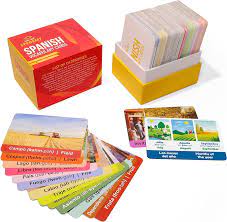
“251 Spanish Verbs Learning Flash Cards Flashcards for Beginners” by Docdeer is a good option for people who want to study verbs in Spanish. This set of 251 Spanish verb flash cards, including verb charts, is highly suitable for adults learning Spanish.
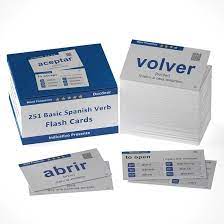
Another good resource is “Pat’s Flash Cards 192 Spanish Beginning Vocabulary Flash Cards with Original Artwork“, the set includes 192 flash cards with nouns, verbs and prepositions. This is suitable for people who want no English on the cards so they must associate the Spanish with the pictures.
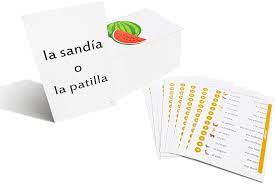
Whether you prefer language learning apps or textbooks, there’s an option out there that can help you achieve your language learning goals.
Spanish For Kids: Easy Words And Phrases To Start Learning
If you are teaching your child Spanish, starting with basic vocabulary and phrases is the first step. This allows children to quickly start communicating in Spanish and creates a strong foundation for further learning. In this section, we’ll explore some of the best vocabulary resources for children to help them begin their journey towards learning Spanish.
Spanish Books for Kids:
There are many great books available that can help children learn Spanish vocabulary. These books are designed to be fun and engaging, with colorful illustrations and simple language that is easy for children to understand. Here are a few:
- “My First English – Español Learning Library” by Wonder House Books: These set of 10 bilingual books cover simple concepts and everyday topics in both the languages to enhance children’ s language skills and build a robust vocabulary. The books included in the Boxset are ABC, Spanish Alphabet, numbers, farm animals and pets, colors, wild animals, shapes, birds, fruits, and vegetables.
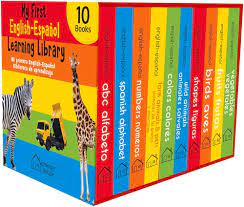
- “Seek & Speak Spanish Words (Happy Fox Books)” by Louise Millar (Author), Louise Comfort (Illustrator): For kids ages 3-5 who are learning how to speak Spanish through seek-and-find activities with question prompts and Spanish word association and pronunciation. It includes 270 Spanish words and 30 visual puzzles of scenes that are familiar to young kids, including the classroom, beach, kitchen, playground, and more.
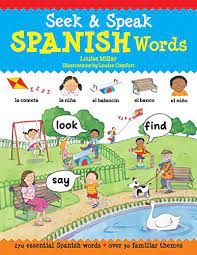
Spanish Apps for Kids:
There are many online resources available that can help children learn Spanish vocabulary. Websites like Duolingo and Babbel offer fun and interactive lessons that are designed specifically for children. These lessons are often gamified, making them more engaging and enjoyable for children. Here are a few to choose from:
Fun Spanish for Kids – Study Cat
This app features:
- Learn 200+ Spanish words and phrases
- Enjoy 12 topics and 70 lessons
- Practice spelling, pronunciation, reading and grammar
- Speak in Spanish from day one!
Spanish for Kids and Beginners – Miracle FunBox
This app is for people who want to help their kids learn Spanish for free or don’t know how to learn Spanish from scratch. Featuring a collection of Spanish vocabulary games for children and beginner learners, this app will help everyone how to speak Spanish.
Spanish School Bus for Kids – Chungaboo
Spanish Flashcards for Kids:
Flashcards are a great way to help children learn Spanish vocabulary. You can create your own flashcards or purchase pre-made ones online. Flashcards are a simple and effective way to help children memorize new words and phrases. Here are a few:
- “Spanish & English Talking Flash Cards for Toddlers 2-4 Years Old” by ANhovno Store: It is particularly suitable for children from bilingual families as part of their early education. The upgraded version of the children’s talking flash card includes a Spanish language function. It allows for easy switching between English and Spanish languages, and uses standard pronunciation and colorful images to attract children’s interest in learning and help them master both languages.
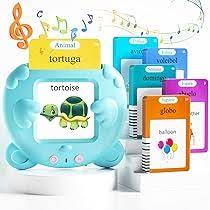
- “Spanish Flash Cards for Kids: 100 First Spanish Words with Online Audio” by Language Together: Beginner flashcards introduce 100 first words covering basic concepts and everyday objects: colors, shapes, numbers 1-10, animals, face/body parts, clothing, family, fruit, snacks, and toys.
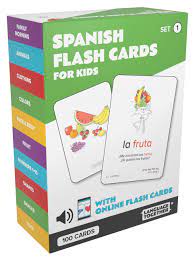
By using these resources, you can help your child learn Spanish vocabulary in a fun and engaging way. Remember to make learning Spanish a part of your daily routine, and to practice regularly to help your child retain what they’ve learned. With time and dedication, your child can become fluent in Spanish and have a lifelong appreciation for the language.
Advanced Learning Vocabulary Strategies
If you are an advanced student looking to improve your Spanish vocabulary, it’s important to have a solid plan in place. Here are some techniques that can help you expand your vocabulary and master complex phrases.
How to learn Spanish Complex Vocabulary and Phrases
To master complex Spanish vocabulary and phrases, it’s essential to have a good understanding of the grammar and sentence structure. One effective way to do this is to read Spanish literature and articles. This will expose you to a wide range of vocabulary and grammar structures, and help you to understand how they are used in context.
As a teacher, I used to share with my students newspaper articles about multiple topics, like cultural events, myths, Latin American traditions, environmental news, opinion articles and more. This helps to learn words in context and identify more complex grammar structures as well as colloquial expressions.
Listening to podcasts is also a great option for more advanced students. Choose podcasts that are only in Spanish to challenge yourself and check your understanding of the language. Youtube videos are also a good alternative if you are morevisual. In my opinion, if you really want to improve your Spanish or if you already have a good command of the language, choose videos that are not meant for learners.
Search on Youtbe for videos about the topics you’re into and find them in Spanish. For example, if you are into travelling, find travel channels, or if you are into health and fitness, start following channels that talk about these topics.
Another resource is to have online conversation practise. There are two ways of doing this. If you want to speak, I recommend finding a language partner. You can either have a language exchange partner or another person who is studying Spanish and has a similar level in order to mantain a conversation. You can find Facebook groups and post your question there.
If you want to learn with a native, the other option is to find an online teacher. There are plenty of options on online platforms like Italki, Preply, and Classgap. You can even choose teachers from different countries to expand your understanding of the accents and cultures.
Techniques for Expanding Vocabulary for Advanced students
For advanced students looking to expand their vocabulary, it’s important to focus on specialized vocabulary that is relevant to your interests and goals. This could include technical vocabulary related to your profession, or vocabulary related to a specific topic that you are passionate about.
One effective way to expand your vocabulary is to use a natural approach, which involves immersing yourself in the language and thinking in Spanish as much as possible. This could include reading Spanish books and articles, watching Spanish movies and TV shows, and listening to Spanish music and podcasts.
Another technique is to focus on reading in Spanish, which can help you to improve your vocabulary and grammar skills. This could include reading Spanish books, newspapers, and online articles. As you read, make note of any new vocabulary words and phrases, and practice using them in context.
From my experience, the best way to learn Spanish vocabulary is to practice regularly and use a variety of techniques that work for you. Explore the resources available and be consistent, don’t give up!

Hi there! I’m Flor, and I’m thrilled to be able to help you with your Spanish! I’m a Spanish online teacher and course creator from the vibrant city of Buenos Aires, Argentina. Whether you’re just starting your language learning journey or looking to further enhance your skills, I’m here to guide you every step of the way. Let’s embark on this exciting learning adventure together!

